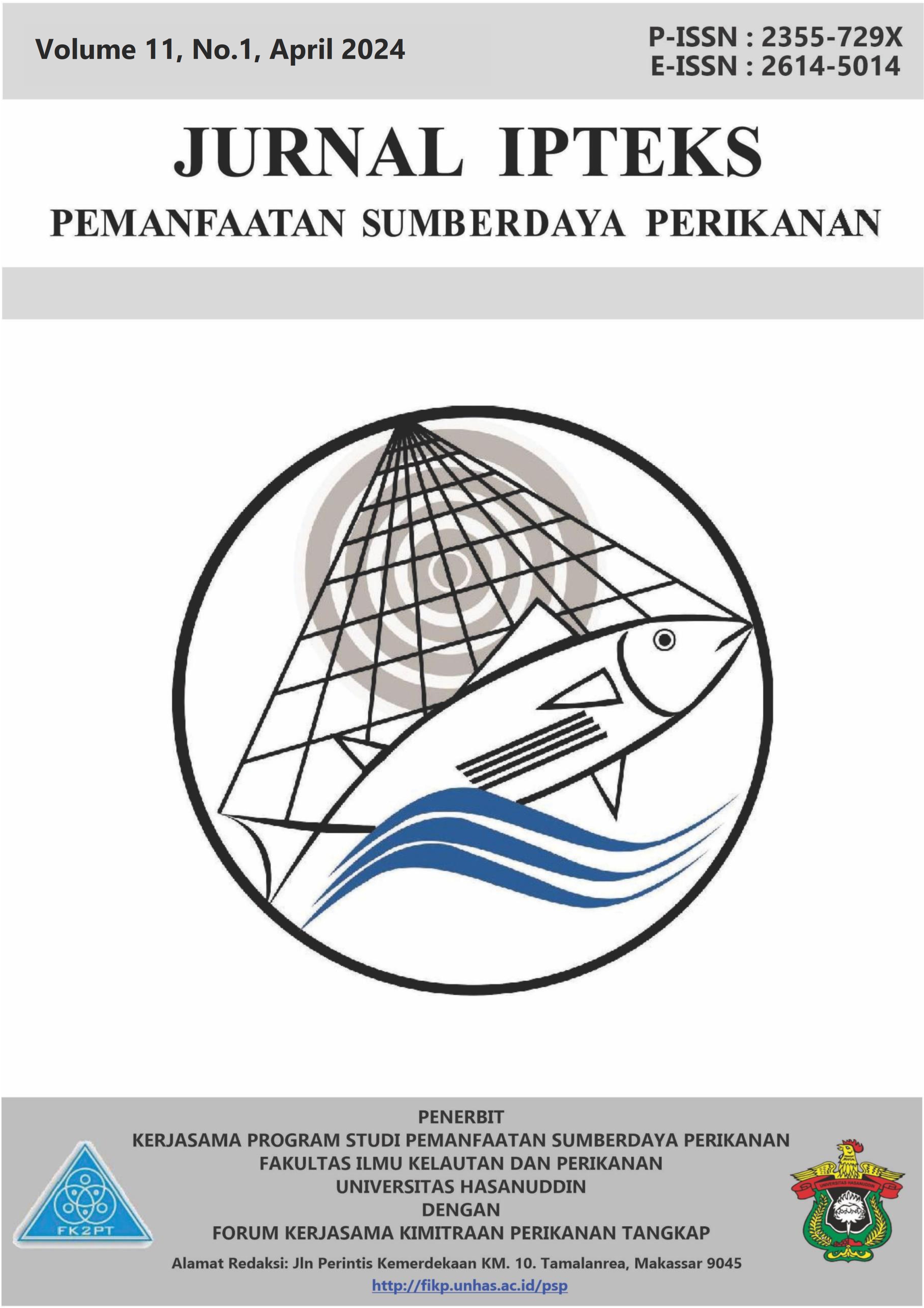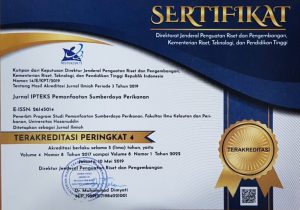Impact of Moon Phases on Purse Seine Fishing Yields in Bulukumba Waters
DOI:
https://doi.org/10.20956/jipsp.v11i1.33209Keywords:
Composition, Frequency, Lunar phases, Purse seineAbstract
The activity of small pelagic fish is influenced by light, so changes in the moon phase will impact the distribution of fish, especially small pelagic fish. Therefore, this research aims to determine the concentration of fish based on lunar phases and explain the composition and frequency of fishing based on lunar phases in Bulukumba Regency. This research aims to provide information to fishermen to determine potential fishing areas. Data was collected in Bulukumba from July to September 2020 following 28 fishing trips using purse seines. The data used are primary and secondary. Primary data consists of the type and number of catches grouped based on lunar phases, namely dark, dark-to-light, light, and light-to-dark periods. Secondary data was obtained from interviews and literature studies. The data analysis used calculates the composition and frequency of catches. The results showed that there were eight types of fish caught during the research. The types of fish most commonly seen are trevally (Decapterus spp), yellow trevally (Selaroides sp), and mackerel (Rastrelliger spp). The highest catch frequency of these three types of fish occurred during the light-dark and light-dark periods.Downloads
References
[BPS] Badan Pusat Statistik Provinsi Sulawesi Selatan, (2020). Laporan Statistik Perikanan Sulawesi Selatan. Makassar. [Indonesia]
Faisol, M., (2015). Pengaruh Hasil Tangkapan Sumberdaya Ikan Selar Kuning (Selaroides leptolepis) yang Didaratkan di PPI Desa Kranji, Kecamatan Paciran, Kabupaten Lamongan. Jurnal Ilmu Eksakta, Vol. 3 No. 2 September 2015. [Indonesia]
Febriani, R. (2014). Studi Tentang Komposisi Jenis dan Kepadatan Organisme Penempel Pada Rumpon Sebagai Alat Bantu Penangkapan Ikan di Perairan Teluk Mallasoroo Kabupaten Jeneponto. [Skripsi]. Program Studi Pemanfaatan Sumberdaya Perikanan. Universitas Hasanuddin: Makassar. [Indonesia]
Hamka, E. & M. Rais. (2016). Penentuan Musim Penangkapan Ikan Layang (Decapterus spp) di Perairan Timur Sulawesi Tenggara. Jurnal IPTEKS PSP, Vol.3 (6) Oktober 2016 : 510 - 517 ISSN: 2355-729X. [Indonesia]
Hikmah, N., M. Kurnia & F. Amir. (2016). Pemanfaatan Teknologi Alat Bantu Rumpon Untuk Penangkapan Ikan di Perairan Kabupaten Jeneponto. Jurnal IPTEKS PSP, Vol.3 (6) Oktober 2016 : 455 – 468 ISSN: 2355-729X. [Indonesia]
Jatmiko, G.G., (2015). Analisis Pengaruh Periode Hari Bulan terhadap Hasil Tangkapan dan Pendapatan Usaha Perikanan dan Ilmu Kelautan. [Skripsi]. Institut Pertanian Bogor: Bogor. [Indonesia]
Kolding, J., P. van Zwieten, F. Marttin, S. Funge-Smith & F. Poulain. (2019). Freshwater
Small Pelagic Fish and Fisheries in The Main African Great Lakes and Reservoirs in
Relation to Food Security and Nutrition. (No. 642). FAO Fisheries and Aquaculture
Technical Paper No. 642. Rome. FAO. 124 pp. Rome.
Marchesan, M., M. Spoto, L. Verginella, & E.A. Ferrero. (2005). Behavioural effects of artificial light on fish species of commercial interest. Fish. Res. 73, 171–185.
Mbabazi, D., H. Nakiyende, E. Muhumuza, S. Bassa, F. Kato & J. Kizza. (2019). Economic
Value of Small-Scale Fisheries in The Victoria Nile-Lake Albert Delta, Uganda: Implications for Nutritional Food Security. Nat. Faune 32, 30–37.
Nguyen, K.Q., & Winger, P.D. (2019). Artificial light in commercial industrialized fishing applications: a review. Rev. Fish. Sci. Aquac. 27, 106–126.
NELSAP. (2019). Regional Technical Report of Catch Assessment Surveys (CAS) Conducted On the Uganda and Democratic Republic Of Congo (DRC) Sides Of Lakes Edward And Albert Between July And August 2019 By Nafirri And SENADEP. Kigali.
Nuitja, I. N. S. (2010). Manajemen Suberdaya Perikanan. IPB Press. Bogor. 168 hal. [Indonesia]
Prahadina, V. D., M. Boer & A. Fahruddin. (2015). Sumberdaya Ikan Kembung Lelaki (Rastrelliger kanagurta Cuvier 1817) Di Perairan Selat Sunda yang Didaratkan di PPP Labuan, Banten. Marine Fisheries, Vol. 6, No. 2, November 2015 Hal: 169-175. ISSN 2087-4235. [Indonesia]
Sahrhage, D., & L. Lundbeck. (1967). A History of Fishing, 1st ed, Angewandte Chemie International Edition. 6(11), 951–952. Springer-Verlag Berlin Heidelberg 1992, Berlin Heidelberg 1992.
Sidiyasa, K., Zakaria, & R. Iwan. (2006). Hutan Desa Setulang dan Sengayan Malinau, Kalimantan Timur Potensi dan Identifikasi Langkah-Langkah Perlindungan dalam Rangka Pengelolaannya Secara Lestari. Inti Prima Karya Indonesia. Bogor. [Indonesia]
Solomon, O. O. & O. O. Ahmed. (2016). Fishing with light: Ecological consequences for
coastal habitats. Int. J. Fish. Aquat. Stud. 4, 474–483.
Sudirman & A. Mallawa, (2004). Teknik Penangkapan Ikan. Rineka Cipta: Jakarta. [Indonesia]
Wiyono, E.S. (2012). Pengaruh Lama Melaut dan Jumlah Hauling Terhadap Hasil Tangkapan Ikan pada Perikanan Gill Net Skala Kecil di Pekalongan Jawa Tengah. Jurnal Teknologi Perikanan dan Kelautan Vol.3.No.1, November 2012. : 57 – 64. [Indonesia]
Yami, B. (1976). Fishing with light. FAO fishing manuals.
Downloads
Published
Issue
Section
License
Copyright (c) 2024 Jurnal IPTEKS Pemanfaatan Sumberdaya Perikanan

This work is licensed under a Creative Commons Attribution 4.0 International License.










